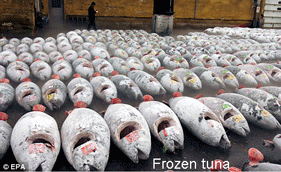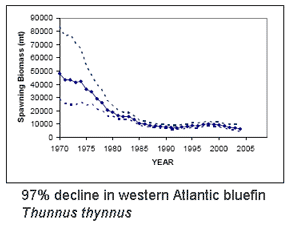Identifying ocean’s racehorses with DNA
 Bluefin tuna are enormous (up to 15 ft/4.5 m, 680 kg/1500 lbs), high-speed (up to 54 km/h, as fast as racehorses) creatures that roam across oceans and return to ancestral waters to spawn. High demand has fueled intensive fishing by international fleets, resulting in 90% population declines heading towards extinction for all three species, Southern (Thunnus maccoyii), Northern (T. thynnus), and Pacific bluefin (T. orientalis). This week in PLoS ONE researchers from the American Museum of Natural History describe DNA-based identification of bluefin and other tuna species using character analysis of COI barcode sequences. Lowenstein and colleagues’ report provides a basis for routine identification of marketplace items to inform consumers and enable enforcement of regulations, including a proposed listing as endangered under Convention of International Trade in Endangered Species (CITES).
Bluefin tuna are enormous (up to 15 ft/4.5 m, 680 kg/1500 lbs), high-speed (up to 54 km/h, as fast as racehorses) creatures that roam across oceans and return to ancestral waters to spawn. High demand has fueled intensive fishing by international fleets, resulting in 90% population declines heading towards extinction for all three species, Southern (Thunnus maccoyii), Northern (T. thynnus), and Pacific bluefin (T. orientalis). This week in PLoS ONE researchers from the American Museum of Natural History describe DNA-based identification of bluefin and other tuna species using character analysis of COI barcode sequences. Lowenstein and colleagues’ report provides a basis for routine identification of marketplace items to inform consumers and enable enforcement of regulations, including a proposed listing as endangered under Convention of International Trade in Endangered Species (CITES).
 The eight species in genus Thunnus are not discriminated by regularly used nuclear loci and differ by about 1% or less in mitochondrial coding regions (e.g., Ward et al 2005 Phil Trans R Soc B), challenging DNA-based identification. To construct a diagnostic key, Lowenstein and colleagues analyzed 89 COI sequences in GenBank representing the eight tuna species and by visual inspection found 14 sites that provided 17 “compound characteristic attributes (CAs)” (terminology from Sarkar et al 2008 Mol Ecol Res). Turning marketplace detectives, the AMNH team collected 68 sushi samples from 31 establishments in New York and Denver over 6 month period in 2008. Nearly one-third (22; 32%) of samples were sold as species contradicted by the molecular data, including items from over half (19; 61%) of the restaurants.
The eight species in genus Thunnus are not discriminated by regularly used nuclear loci and differ by about 1% or less in mitochondrial coding regions (e.g., Ward et al 2005 Phil Trans R Soc B), challenging DNA-based identification. To construct a diagnostic key, Lowenstein and colleagues analyzed 89 COI sequences in GenBank representing the eight tuna species and by visual inspection found 14 sites that provided 17 “compound characteristic attributes (CAs)” (terminology from Sarkar et al 2008 Mol Ecol Res). Turning marketplace detectives, the AMNH team collected 68 sushi samples from 31 establishments in New York and Denver over 6 month period in 2008. Nearly one-third (22; 32%) of samples were sold as species contradicted by the molecular data, including items from over half (19; 61%) of the restaurants.
Lowenstein found their character-based identifications were more accurate and precise than those provided by BOLD ID engine (www.barcodinglife.org), largely reflecting that the ID engine uses a 2% cutoff for assigning specimens to species, which encompasses all eight Thunnus sp. In addition, BOLD is a workbench for researchers and so contains many as yet unpublished sequences from ongoing studies; these need to be viewed as provisional data. Indeed, in constructing their key Lowenstein and colleagues set aside 2 of the 89 GenBank tuna sequences as these grouped with other species. These anomalous sequences might reflect hybridization or introgression which is reported to occur in 2-3% of Atlantic bluefin, for example (Viñas and Tudela 2009 PLoS ONE). In this study, researchers from Universitat de Girona, Spain and World Wildlife Fund describe a DNA-based method for distinguishing tuna species using mitochondrial control region and nuclear ITS. Here again the method is validated using published data, in this case 42 GenBank records representing the 8 species. As an aside, I find it remarkable there are so few records that might enable identification of such commercially-important and now endangered species. These two studies establish a scientific and possible legal standard for tuna identification. Now we begin.
This entry was posted on Thursday, November 19th, 2009 at 9:44 pm and is filed under General. You can follow any responses to this entry through the RSS 2.0 feed. Both comments and pings are currently closed.
November 23rd, 2009 at 4:34 am
[…] as bluefin or bigeye tuna. Wired Science, LiveScience, Uncommon Ground, Thriving Oceans and the Barcode Blog all discussed the […]